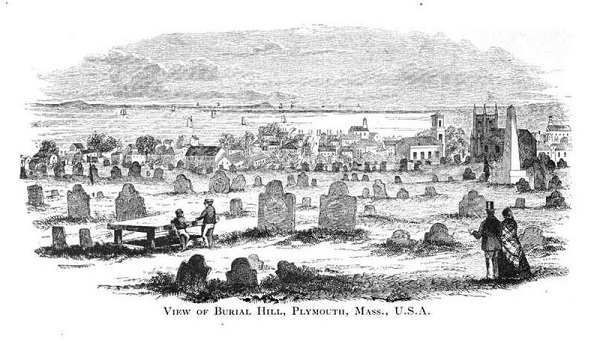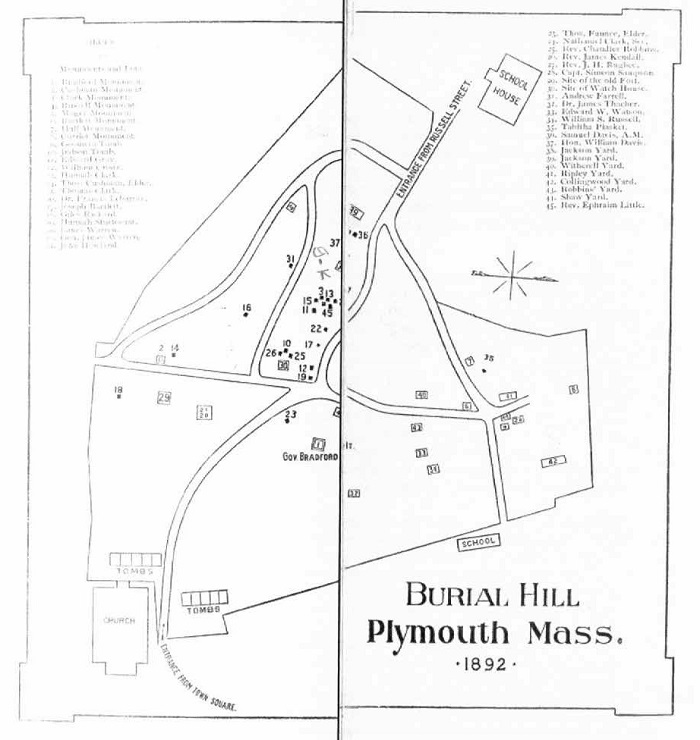Burial Hill is a historic cemetery in Plymouth, Mass. The cemetery is the second oldest cemetery in Plymouth and was established sometime in the 17th century, possibly around 1679.
The cemetery is 5.12 acres in size and is home to 2,269 headstones, including four from the 17th century, and a number of unmarked graves as well as a handful of historical monuments. The cemetery is located on a hill that stands about 165 feet above sea level.
Fort Hill History:
Prior to becoming a cemetery, the hill was originally known as Fort Hill because it was the site of Plymouth colony’s fort, which was built in 1621. This fort also served as the colony’s meeting house until 1677.
The first fort built there consisted of a wooden platform with cannons on top. The second fort was built in 1622 near the southeast corner of the cemetery and was much larger and included a stockade around it. This fort consisted of a large square house with a flat roof with six cannons on the roof. The ground level was used as a church.
The fort was enlarged again in 1630-35 and again in 1642. In 1643, a brick watch house was built inside the stockade.
Decades later, in February of 1676, due to the threat of King Philip’s War, a large wooden two-story 100-square-foot fort was built on Fort Hill complete with palisade walls ten and a half feet high. After King Philip’s War ended in late 1676, the fort was abandoned.
In 1679, the fort was awarded to Samuel Jenney, who dismantled it and sold the timber to William Harlow, who used it to build the Harlow Old Fort House that still stands on Sandwich Street in Plymouth today.
Burial Hill Cemetery:
After the fort was abandoned, the colonists began to use the hill as a cemetery.
In 1681, the oldest headstone was placed when Edward Gray died. It is believed that there are older graves in the cemetery but they were marked by wooden markers that have since deteriorated.
The majority of the headstones are from before 1850. About 1,400 of the headstones are made of slate, sandstone or schist, which were the primary material for headstones prior to 1820, while about 750 are marble or granite. The earliest headstones are about 2 feet tall and made of purple or gray schist.
Early burials were primarily near the top of the hill. The cemetery originally had a series of rough dirt paths that led to these early graves at the top of the hill.
In 1770, a brick powder house was built in the northwest corner of the burial ground to house the town’s arms and ammunition supplies.
In December of 1778, the brigantine General Arnold wrecked on a sandbar off the coast of Plymouth and 72 sailors froze to death and were buried in an unmarked mass grave somewhere on Burial Hill.
By the early 1800s, marble headstones became more common in Burial Hill cemetery.
In 1835, a monument to William Bradford was erected in the cemetery. The monument is an 8 foot-tall marble obelisk on a granite and marble base with an inscription that reads:
“Under this stone rest the ashes of Willim (sic) Bradford, a zealous puritan & sincere Christian. . .”
It is debatable whether Bradford is actually buried at Burial Hill but some historians, such as 19th century historian James Thatcher, believe he is.
By the 1850s, the number of new burials in Burial Hill had greatly declined because Plymouth residents preferred to be buried in the newer cemeteries. The burials that did occur took place in family lots that had already been established around the perimeter of the cemetery.
In the 19th and 20th century, a number of monuments were erected in the cemetery.
The first was the Cushman Monument which was erected in the cemetery in 1858 in honor of Robert Cushman, his son Thomas Cushman and Thomas’ wife Mary Allerton Cushman who was the last surviving Mayflower passenger when she died in 1699. Robert was instrumental in arranging the Mayflower voyage and Thomas had served as the ruling elder of Plymouth colony for 43 years. The monument is a 25-foot-tall granite obelisk set on a multi-tiered base. It is the tallest monument in the cemetery and is located near the summit.
By 1870, a wide gravel path was constructed from the main entrance to the top of the hill.
In 1880, the brick powder house was demolished because it had deteriorated.
By 1892, the path system was expanded as the cemetery grew and secondary entrances were established on Church Street, School Street and South Russell Street. The paths are now paved with asphalt.
In the 1890s, new gates and granite steps were constructed for the main entrance. The gates are Romanesque-style and were designed by landscape architect Ernest W. Bowditch.
In 1897, the John Howland monument was erected at the supposed location of his grave. The monument is a purple-slate monument with an image of ship at full sail at the top with a scallop shell on each side.
John Howland had died in 1673 and, since there are no headstones dating back that early, it is uncertain whether he is actually buried in the cemetery. His ancestors placed the monument there assuming that since his descendants were buried there, he must have been buried there too.
During the 19th century, a group of granite tombs and brick tombs were constructed in the cemetery.
Sometime in the late 19th century the Judson Monument was erected at the head of the main path of the cemetery in honor of Baptist missionary Adoniram Judson who died at sea. The monument is a large slab of white marble placed horizontally on six columns resting on stones and enclosed by a wooden fence.
Also by the late 19th century, polished granite headstones became more popular in Burial Hill and the headstones became more standard in design.
In 1914, the cemetery began using special markers to denote the graves of military veterans.
In 1920, the new powder house was constructed on the site of the old powder house to celebrate the town’s tercentenary events. A bronze plaque on the powder house reads:
“The Old Powder House was built here in 1770. This building erected in 1920 is dedicated to those descendants of the Pilgrims, by birth or by spirit, who helped establish American independence. — Massachusetts Society of the American Revolution.”
A marble plaque by stone carver William Coye, which was originally on the outside of the old powder house, is now located on the inside of the new powder house to protect it from the elements.
In 1921, the Ancient and Honorable Artillery Monument was erected on the site of the original fort in honor of the fort’s history. The monument consisted of two cannons and a bronze plaque on a concrete platform built into the hillside. The cannons eventually deteriorated though and had to be removed.
In 1923, the James Warren Monument was erected at the Warren family plot by the Sons of the Revolution to honor James Warren, the President of the Massachusetts Provincial Congress. The monument is a low relief bronze bust in granite surround.
In 1926, the Scammel Monument was erected on the eastern edge of Burial Hill in honor of Alexander Scammel, a Plymouth schoolteacher who joined the Continental Army during the Revolutionary War and was mortally wounded at the Battle of Yorktown. The monument is a boulder with a low-relief bronze portrait plaque.
In 1930, the John Alden House Monument was erected on the eastern edge of Burial Hill at the former site of John Alden’s house. The monument consists of a boulder with a bronze plaque that reads:
“Site of the House where John Alden lived while in Plymouth”
The last two burials at Burial Hill were for Stephen Spooner, who died in 1954, and Anna Klingenhagen, who died in 1957, both whom were buried next to family members.
Burial Hill was added to the National Register of Historic Places in 2013.
In April of 2019, the Plymouth Select Board voted in favor of requesting permission from the Massachusetts Historical Commission to excavate a section of the cemetery where it is believed the mass grave from the wreck of the General Arnold is located. It is not clear if or when excavation work will begin.
Who Is Buried at Burial Hill Cemetery?
There are 79 Revolutionary War veterans, 12 War of 1812 veterans and 48 Civil War veterans buried at Burial Hill. There are also a surprisingly large number of children’s graves in the cemetery.
It is not confirmed that any of the Mayflower pilgrims are buried in the cemetery but is assumed that they might be. Many of the pilgrims died before the cemetery was officially established so it seems unlikely but it is not impossible.
It is also rumored that Squanto was buried in Burial Hill but it is unlikely that he is buried in Plymouth at all since he died unexpectedly in 1622 during an expedition to Chatham on Cape Cod and was most likely buried there instead. A marker on the grounds of the historic Nickerson House in Chatham states that Squanto was buried somewhere in that location in 1622.
The following is a list of people who are buried or assumed to be buried in Burial Hill:
Richard Warren, died 1628, Mayflower passenger
William Brewster, died 1644, church elder
Edward Doty, died 1655, Mayflower passenger
William Bradford, died 1657, Mayflower passenger and governor of Plymouth Colony
Francis Cooke, died 1663, Mayflower passenger
John Howland, died 1673, Mayflower passenger
Elizabeth Walker Warren, died 1673, Anne passenger
Thomas Prence, died 1673, Colonial Governor
Mary Allerton, died 1699, last surviving Mayflower passenger
Captain Simeon Simpson, died 1789, first naval officer commissioned by the Massachusetts Provincial Congress, served on the Brigadine Independence
Alexander Scammell, died 1781, Plymouth schoolteacher who joined the Continental Army and was mortally wounded at the Battle of Yorktown
General James Warren, died 1808, president of the Massachusetts Provincial Congress and a paymaster general of the Continental Army, buried with a marble headstone in the Warren family plot
Mercy Otis Warren, died 1814, political writer and advocate for American independence
Zabdiel Sampson, died 1828, Congressman
Dr. James Thatcher, died 1844, a surgeon in the American army
Adoniram Judson, died 1850, Christian missionary to Asia
For more info on historic locations in Plymouth, check out this list of Plymouth historic sites.
Sources:
Kingman, Bradford. Epitaphs from Burial Hill, Plymouth, Massachusetts, from 1657 to 1892. New England Illustrated Historical Publishing Company, 1892.
Clark, Emily. “Plymouth Select Board Oks Dig for Mass Grave at Burial Hill.” The Telegram, 26 April. 2019, telegram.com/news/20190426/plymouth-select-board-oks-dig-for-mass-grave-at-burial-hill
“Burial Hill National Register of Historic Places Nomination.” Plymouth-ma.gov, plymouth-ma.gov/sites/g/files/vyhlif3691/f/uploads/burial_hill_national_register_nomination.pdf
“Burial Hill Map Book 1.” Plymouth-ma.gov, plymouth-ma.gov/sites/g/files/vyhlif3691/f/uploads/burial_hill_map_book_1_of_2.pdf
“Burial Hill Map Book 2.” Plymouth-ma.gov, plymouth-ma.gov/sites/g/files/vyhlif3691/f/uploads/burial_hill_map_book_2_of_2.pdf
“Burial Hill Cemetery.” Plymouth-ma.gov, plymouth-ma.gov/cemetery-and-crematory-management/pages/burial-hill-cemetery







